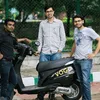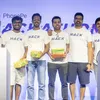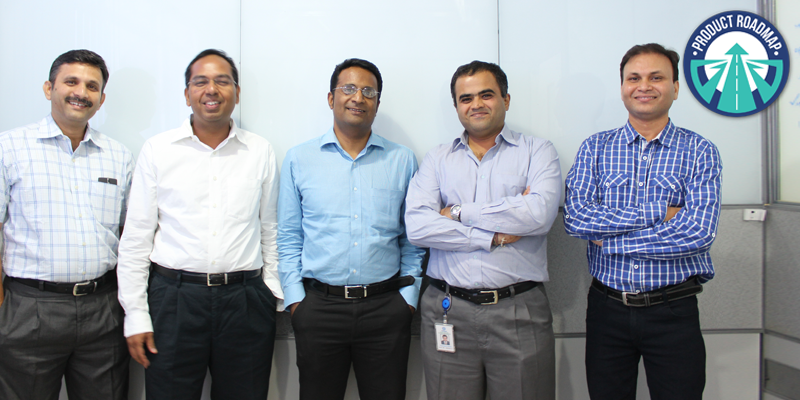
The founding team of Stellapps
In 2011, when five techie friends from Wipro – Ranjith Mukundan, Ravishankar G, Shiroor Praveen Nale, Ramakrishna Adukuri, and Venkatesh Seshasayee – were thinking of starting up, they saw major problems in the production process of one of the largest consumables in India – milk.
The friends realised that the yield per animal was low, traceability was a challenge, and quality was a big concern. Close to 76 million homes in India are a part of dairy farming, and 66 percent of them are marginal farmers. Yet, the milk productivity in India is as low as 1/9th of that of the US.
Ranjith Mukundan tells YourStory that this is primarily due to lack of preventive healthcare, proper nutrition, veterinary assistance, and reproductive management for cattle. These have been responsible for adversely impacting the profitability of smallholder dairy farmers.
Also, limited access to formal credit and insurance keep the farmers from investing in dairying and prospering to dairy entrepreneurs.
There was a strong need for technological interventions. It led them to start Stellapps, a farm-to-consumer dairy digitisation service provider that improves productivity, enhances quality, and ensures end-to-end traceability across the dairy supply chain.
“Our major hack has been to cover the entire dairy supply chain. By focusing on the whole dairy supply chain instead of a single node, we were able to unlock more value for each stakeholder. Our products now span all aspects of dairying, as a result of which they are being deployed by every major dairy in India,” says Ranjith.
Through its customer base, which includes all major private and co-operative dairies, Bengaluru-based Stellapps digitises about 10 million litres of milk worth $3.4 million every day. This directly impacts two million dairy farmers in over 28,000 villages.
Leveraging AI to build a full-stack model
The startup focuses on leveraging advanced analytics and artificial intelligence through its full-stack IoT platform to enable the dairy ecosystem to partner with financial and insurance institutions, veterinary services, cattle nutrition providers etc. This is done to drive significant value for each stakeholder, especially the marginal farmers.
Their IoT platform, SmartMoo, acquires data through sensors that are embedded in animal wearables (mooON device), milk chilling equipment (ConTrak), and milk procurement peripherals (smartAMCU/smartCC). These products are focused on improving the supply chain efficiency, preventing adulteration, and enabling traceability.
Ranjith explains that the data collected is then transmitted to the Big Data Cloud Service Delivery Platform (SDP) where the Stellapps SmartMoo suite of applications analyse and crunch the received data before disseminating the outcome to various stakeholders over low-end devices and smartphones.
“We started with farm side solutions – milking and chilling systems. The first product that gave us scale was for milk collection centres – smartAMCU. Earlier, milk was mostly collected manually, with only basic tests conducted and collection data recorded that was physically sent to dairy processors for payment reconciliation,” he says.
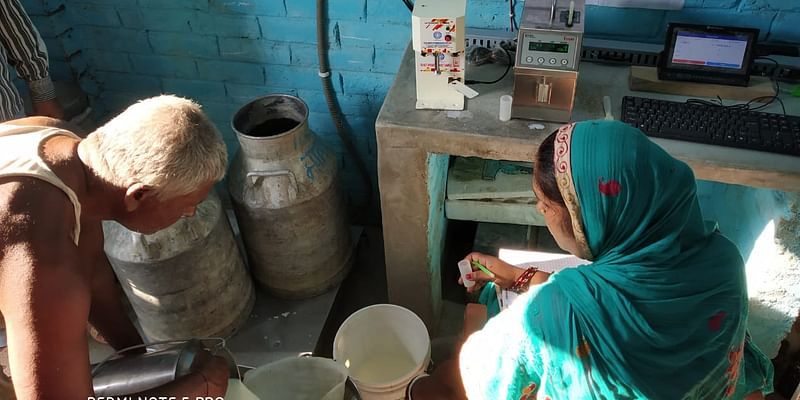
Stellapps is a dairy digitisation service provider | Image Credits: Stellapps
Addressing the entire stack
SmartAMCU automates the entire process by collecting milk quality/quantity data from various sensors and makes it available to the dairy processors on a real-time basis. It allows dairies to pay a higher price for better quality milk, which is visible to other farmers in the collection centre.
The transparency results in a positive cycle of upgrading the quality of milk collected in the entire centre and de-incentivises farmers to resort to milk adulteration. This, the founders say, is a win-win situation for dairies, farmers, and end consumers.
Stellapps has also integrated its platform with banking APIs to facilitate payments directly to farmers’ bank account, and is also helping farmers get access to credit (cattle financing) through its partner banks using its proprietary creditworthiness assessment model.
It is also partnering with one of the world’s leading animal nutritional provider to use the farm data (mooON) to give contextual nutrition advisory and farm management advisory to farmers. Such intervention measures enable farmers to improve their productivity and milk quality, and hence, increases their income from dairy.
The smartMoo solutions not only aim to digitise the dairy supply chain from farm to fork, but also try to create a conducive ecosystem for the prosperity of smallholder farmers.
Overcoming the challenges
“Once we built out an extensive network of our digital solutions, we started focusing on the more complex farm side challenges – low productivity, quality issues, lack of access to financial and extension services. This led to the conception and development of solutions like mooON, mooPay, mooFlow, mooGrow etc,” says Ranjith.
Ranjith explains that these challenges were relatively easier to fix as they found a reliable customer base in dairy processors. They now drive digitisation through their smartMoo suite of applications.
The smartMoo Digital Access Network collects data from each node of the supply chain – cattle, farmer, village milk collection centre, and chilling centre. The mooON device collects cattle activity data and the mooON app records animal health, yield, and nutrition data. This enables conducting preventive health care, performing artificial insemination at the right time, providing better nutrition, and increasing productivity.
“We deliver the right nutrition to the cattle with our mooGrow solutions. mooID compares the body images to authenticate and identify the cattle. Our fintech solution, mooPay, links farmer to financial services like credit and insurance, and enables direct farmer payments,” says Ranjith.
The smartAMCU and smartCC offerings enable transparent, traceable and efficient milk procurement at the collection centres. ConTrak helps keep milk fresh in the cold chain, while mooFlow ERP helps in seamless dairy operations.
“We crunch the data collected by our smartMoo Digital Access Network and offer data-based business insights to dairy companies through our mooOpt consultancy solution,” explains Ranjith.
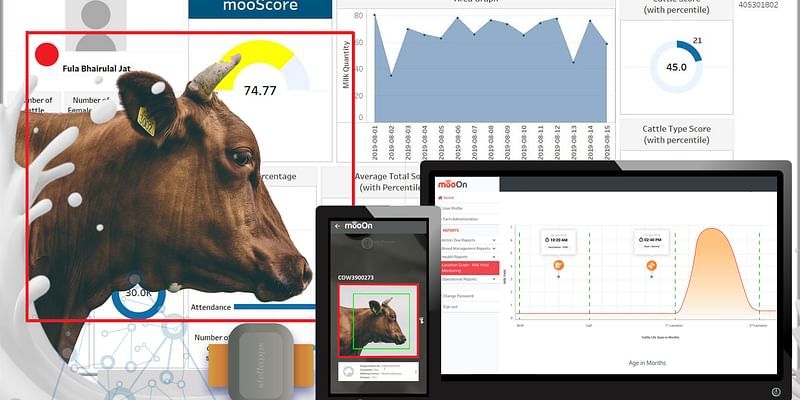
Image credits: Stellapps
Fixing the bugs
Though the team didn’t face many challenges on the software scaling front, Ranjith explains that it was a task to figure out the type of users to target the product. A few initial products like the fully-automated milking systems didn't exactly fit the market requirement of small farm holdings.
“We discontinued that product and focused on improving farms by collecting as much data on the mooOn app, using bucket milking systems, providing advisories to farmers on better farm management, and supporting them with multiple financial and insurance products,” says Ranjith.
There were also challenges on gathering data, which were met by continuously automating tasks, and using IoT and sensors to automatically gather data rather than being manually fed. Based on field and end-user feedback, the product lines are continuously enhanced with better functionality. For example, all smartAMCU sensing equipment such as milk analyser, weighing scale, and remote display were converted to wireless.
On-ground feedback
The app for farmers, mooOn, is continuously updated based on the feedback. New features such as automatic cow recognition, introducing multi-modal inputs such as using speech, local language etc, are being added to ease the data entry. Similarly, cold chain monitoring app - ConTrak was made wireless to connect with various sensors such as those noting the temperature of milk in chillers. The connectivity for each of the products is being upgraded to 4G.
Ranjith explains, “We received continuous feedback from the ground, our customers, and our advisors–which include industry and academic veterans from RTBI-IITM, Omnivore, WRVI, Qualcomm, ABB and others. This made us realise that we need to tap and monitor the entire milk supply chain to maintain traceability and increase its overall efficiency.”
He adds that is how the existing products came to life – smartCC, for monitoring chilling centres, mooPay – for direct farmer payments and farmer loans, mooKare – for cattle insurance, mooOn wearables – to monitor cow health, mooScore – for farmer creditworthiness, and mooGrow – for better cow nutrition.
For each of the products, the team offers its customers an upgrade path as part of the SaaS offerings. The software upgrades are regularly released and the hardware upgrades are planned as per the convenience of the customers.
“We have a dedicated support team to take continuous feedback from our customers and route new feature requests to the product management. We have products up and running for years now, monitoring the dairy supply chain 24x7 with continuous, proactive support and maintenance for each of them,” adds Ranjith.
Looking at the milk market
While startups like MilkBasket and BigBasket Daily are focused on milk delivery, few are integrating the farm-to-consumer model.
In an earlier conversation with YourStory, Sudhir Rao, Managing Partner of IndusAge Partners, had said, “Organised milk in India is a $70 billion industry growing at 23 percent annually, with a homogenous business value chain that benefits virtually every farming household in the country.” Another startup looking at the space of milk delivery from the farm model is Bhubaneshwar-based Milk Mantra.
Ranjith distinguishes Stellapps by saying that they integrated several technological solutions while developing the products. Initial products focused on basic data gathering using IoT, but now the team uses analytics and performs machine learning on the collected data.
“Important stakeholders are given very pointed feedback about the current functioning of the supply chain rather than have them traverse through large amounts of data. Dashboards give a quick glimpse of how the entire chain is functioning, which are the below-par areas that need to be improved upon and need immediate attention. Farmers and vets are alerted when the cows need proper nutrition, medical attention or artificial insemination at the right time. The current suite of Stellapps product offerings reflect these improvements, and more are being developed,” says Ranjith.
He reveals that the team has had a lot of eureka moments and learnings, especially in the rural areas – be it the acceptance of apps by non-tech-savvy users, the availability of power infrastructure with frequent surges and outages, or remoteness of the deployment sites.
Each of these conditions helped the team to improve their products – such as introducing local language and multi-modal support. The products work on solar power and are designed to be power-efficient, with most of the computations done on the cloud and have alternate mechanisms for transferring data.
“We now cover every aspect of milk production and procurement. We are in the process of developing products on the distribution side as well,” says Ranjith.
(Edited by Kanishk Singh)
Want to make your startup journey smooth? YS Education brings a comprehensive Funding Course, where you also get a chance to pitch your business plan to top investors. Click here to know more.
Link : https://yourstory.com/2020/08/product-roadmap-stellapps-startup-milktech-iot
Author :- Sindhu Kashyaap ( )
August 12, 2020 at 05:50AM
YourStory


